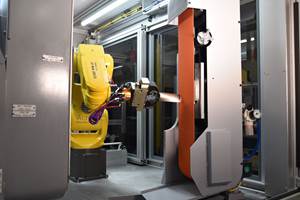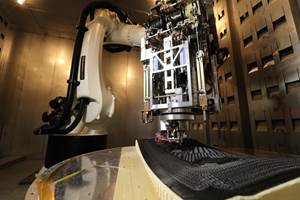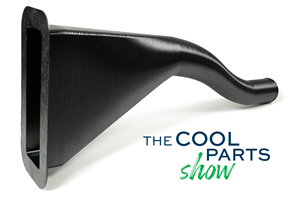Hexagon, Stratasys Unlock 3D Printed PEKK’s Lightweighting for Aerospace
The companies say the rigorously validated multiscale models of these high-performance, aerospace-approved materials have been added to Hexagon’s Digimat materials exchange ecosystem with associated print process parameters from Stratasys’ aerospace-ready 3D printers.
This pie-shaped component is part of the hatch cover assembly for NASA’s Orion spacecraft. It was 3D printed using Stratasys’ Antero 840CN03, a PEKK-based thermoplastic with low outgassing and consistent electrostatic dissipative properties. Antero 840CN03 gives manufacturers a high-performance, ESD-compliant 3D printing material that meets demanding applications such as space flight. Photo Credit: Stratasys
Hexagon’s Manufacturing Intelligence division and Stratasys, a provider of polymer 3D printing solutions, have applied Hexagon’s simulation technology to capture the behavior of Stratasys’ high-performance, ultralightweight Antero-reinforced polyetherketoneketone (PEKK) materials and its additive manufacturing (AM) processes. These validated simulations are said to offer Stratasys customers unique insight so they can lightweight components and introduce new sustainable aircraft and spacecraft faster.
It is said 3D printed plastic parts offer transformative lightweighting for aerospace, thereby reducing the energy use and increasing the range of new aircraft. When the material and processes are fully exploited by product designers, it may also reduce the cost caused by overengineering, and the waste and lead times of traditional manufacturing.
However, the adoption of plastics and additive methods for structural components has remained slow due to the industry’s safety-critical nature and regulations. The team says that providing engineering teams with the simulation tools to validate that these materials will achieve the required part performance when manufactured is the “missing link,” enabling designers to apply these breakthroughs today.
According to the companies, rigorously validated multiscale models of these new high-performance aerospace-approved materials — Stratasys Antero 840CN03 and Antero 800NA — have now been added to Hexagon’s Digimat materials exchange ecosystem, with associated print process parameters from Stratasys’ aerospace-ready 3D printers. Using these detailed proprietary models, engineers can create digital twins that accurately predict how parts printed with the chosen material and approved aerospace-ready Stratasys printer will perform in a digital reality with real-world use cases and certification tests before any physical prototypes are manufactured.
Developed to be open, Digimat software gives manufacturers the ability to design lighter parts that can match metals in performance and avoid costly overengineering using preferred finite element analysis (FEA) and computer-aided engineering (CAE) tools. Moreover, companies that use Digimat in conjunction with Hexagon’s MSC Nastran and MSC Apex can accelerate the certification and documentation of their work.
The Antero materials are already being used at the cutting edge of aerospace engineering such as Lockheed Martin using Antero 840CN03 to create NASA’s Orion spacecraft docking hatch cover. By making rigorous digital engineering and virtual manufacturing possible with these new simulation tools, more product development teams can apply and de-risk Stratasys’ aerospace AM solutions.
“As the aerospace industry continues to push for more sustainable designs, unlocking the lightweighting potential of thermoplastics and 3D printing will be key,” says Aziz Tahiri, vice president of global aerospace and defense for Hexagon’s Manufacturing Intelligence division. “By leveraging the power of our simulation technology, manufacturers gain access to proprietary information so their engineers can ‘work the problem’ with reliable information. We’re excited to see how this next chapter with Stratasys will help the industry create lighter, stronger designs in any design engineering tool with more confidence and less cost, and help bring next-gen aircraft to market faster.”
The team says the Antero 840CN03 and Antero 800NA thermoplastics provide unprecedented strength, heat and chemical resistance. “When combined with Hexagon’s simulation insights and actionable data, these 3D printed materials’ ability to replace certain applications of aluminum and steel clearly points to growing use in the aerospace industry,” says Foster Ferguson, Stratasys aerospace business segment leader. “We believe they meet manufacturers’ increasingly complex performance needs and, by combining innovative modeling software with 3D printing, can reduce production timelines from months to days.”
Through the partnership between Stratasys and Hexagon, which has spanned more than a decade, several high-performance thermoplastic materials — including Ultem 9085, Ultem 9085 CG, Ultem 1010 and Nylon12CF — have been characterized and already added to Hexagon’s Digimat material modeling software.
- Read about the Hexagon collaboration with Stratasys on a validation tool for 3D printed plastic components to help compress design and testing phases, improve understanding of plastic behavior and speed up innovation across the sector.
- Learn about the Hexagon partnership with Raytheon Simulation Tool to improve 3D printing build quality by combining technologies to create a simulation tool that will enable better evaluation and optimization of metal additive manufacturing processes.
- Hexagon’s partnership with Authentise aimed to improve AM quality and repeatability by integrating shopfloor data with data intelligence to orchestrate consistent quality from concept to part.
Related Content
Aircraft Engine MRO: How Additive Manufacturing Plus Robotic Finishing Will Expand Capacity for Blade Repair
AM offers the chance to bring fast, automated processing to individualized, part-by-part restoration of turbomachinery. A cell developed by Acme Manufacturing and Optomec is able to automatically repair 85,000 unique aircraft engine blades per year.
Read MoreHow 3D Printing Will Change Composites Manufacturing
A Q&A with the editor-in-chief of CompositesWorld explores tooling, continuous fiber, hybrid processes, and the opportunities for smaller and more intricate composite parts.
Read MoreAircraft Ducts 3D Printed in Composite Instead of Metal: The Cool Parts Show #68
Eaton’s new reinforced PEKK, tailored to aircraft applications, provides a cheaper and faster way to make ducts compared to formed aluminum.
Read MoreHow Norsk Titanium Is Scaling Up AM Production — and Employment — in New York State
New opportunities for part production via the company’s forging-like additive process are coming from the aerospace industry as well as a different sector, the semiconductor industry.
Read MoreRead Next
Looking to Secure the Supply Chain for Castings? Don't Overlook 3D Printed Sand Cores and Molds
Concerns about casting lead times and costs have many OEMs looking to 3D print parts directly in metal. But don’t overlook the advantages of 3D printed sand cores and molds applied for conventional metal casting, says Humtown leader.
Read MoreTo Improve Performance of Compression Molded Composites, Add 3D Printed Preforms
9T Labs' Additive Fusion Technology enables the manufacture of composite structures with as much or as little reinforcement as is necessary, using 3D printed continuous fiber preforms to add strength just where needed.
Read MoreVideo: Intelligent Layering Metal 3D Printing at 3DEO
Contract manufacturer 3DEO delivers metal parts using Intelligent Layering, a binder jetting-like 3D printing process the company developed and operates internally. Here’s how it works.
Read More











.png;maxWidth=300;quality=90)












